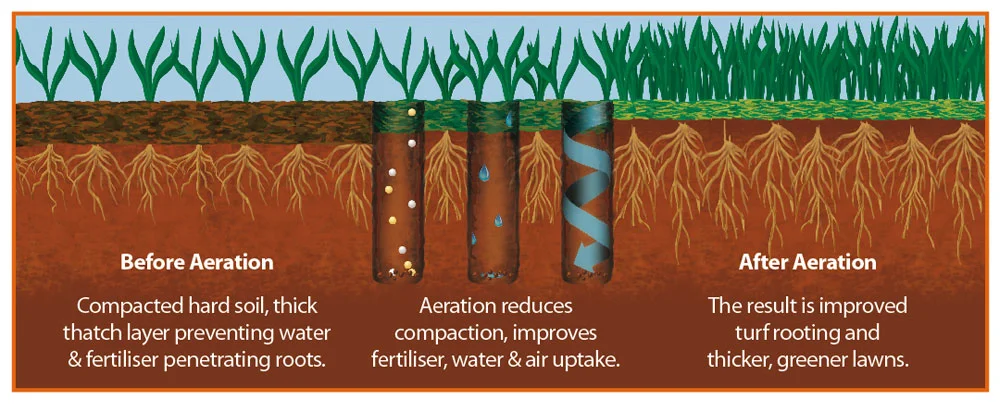Drainage Tips for Winter Wetness
Poor drainage drowning your garden beds or creating a boggy, muddy mess?
Here are our top tips for getting your property winter-ready.
Aerating Soil
Aeration is not just great for a thick green lawn, it also helps with drainage. Aeration breaks the thick thatch-like grass underlay and pierces the compacted soil to help with lawn drainage and absorption. By using a garden fork or a lawn spike aerator to create aeration holes, the water will soak down into the soil and distribute more evenly and deeply. Otherwise in heavy a downpour water will run across the lawn and flood the lowest point of your property.
Image via https://www.greensleeves-uk.com/img/services/aeration_diagram.jpg
Grading
Grading can often be the answer to your drainage issues. Many builders pay little attention to how they grade lots when building new homes. This can leave you with water flowing right into your foundations every time it rains. Grading simply adjusts the slope of your yard to a level that will move ground water away from your house, instead of towards it. Our digger and skid steer have all the attachments to grade your property and our operators have the know-how to get the slopes and levels to fix your drainage problems.
French drain
One of the most common fixes for drainage issues is a French drain. The French drain is simply a trench filled with gravel or rock and usually containing a perforated pipe that redirects surface water and groundwater away from an area. They are used to solve a variety of issues, from keeping water away from foundations to relieving ground water pressure behind retaining walls. If you have an area of your yard that takes forever to dry, then a French drain may be your solution. A drainage pit can also be dug into the ground and linked to the french drain pipe. This is ideal during a heavy downpour as the water has a “holding area” to eases the pressure of excess water in the pipes. The Spade Bucket on the Little Digger is ideal for digging trenches quickly and effectively.
Swale
A swale is basically ditches, or areas where a landscaper purposefully intersects two slopes in order to create a place to hold or funnel water. Able to solve a variety of dilemmas, from capturing water for agricultural purposes to stopping erosion through diversion ditches. Swales can be as simple as a ditch, but they can also be much more complex and purposeful.
Image via http://www.geograph.org.uk/photo/677520
Clearing culverts and drains
Maintaining the existing drainage solutions on your property is essential in the lead up to each rainy seasons.
Many rural properties have culverts. A culvert is a ditch that runs beside (or under) a road or driveway. Culverts give excess water a place to collect and drain into a larger drain system or into the ground. Culverts tend to fill with natural debris; weeds, grass and other summer growth, as well as fallen leaves. Silt, which accumulates over time, can also cause drainage problems. Maintenance is key in avoiding flooding that can damage the driveway/roadway or an adjacent property. Removing the debris should be a part of your culvert maintenance routine. Culvert inlets and outlets should also be examined for signs of deterioration, damage or soil erosion.
When an outdoor drain becomes clogged with leaves, there are several measures you can take to prevent the leaves from causing problems in the future.
The most simple and effective way is to stay on top of raking, blowing and disposing of excess leaves so that they don't end up at the drain site.
Another technique is to shovel the clogged leaves by scooping the mess away and then, using a wet/dry vacuum, pull leaf debris through the grates of the drain cover and whatever is left behind may be washed down the drain with water; as long as the bulk of the debris is removed, the drain should be much easier to clean.
You can also prevent leaves from clogging the drain by using a drain guard. Working like a strainer, the drain guard’s gaps allow water to filter through while blocking the leaves away from the drain’s surface. Drain guards still require regular cleaning, but they work as effective solutions to keep drains from becoming clogged with leaves.
Getting your property winter-ready is an essential part of life in rural New Zealand but Chris and the team have vast experience with drainage solutions.
So give us a call or request a site visit to discuss your drainage needs.



